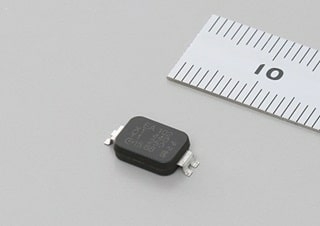source: Murata news
Murata Manufacturing Co., Ltd. has launched a surface mount type IEC 60384-14*1 Y1*2 class safety certified ceramic capacitor for low-profile power supplies. This capacitor is ideal for all AC-DC switching power supplies where a low-profile is sought for compact AV equipment, LED illumination, or 1U*3 rack mounted equipment. The mass production of the capacitor began in May 2017.
Safety certified capacitors are placed at a power line input side in order to eliminate noise that builds up primarily in commercial AC power lines.
Safety certified capacitors are usually of the lead type, but the mounted height above the board surface is a problem because it hinders efforts to make low-profile devices and it limits component layout. In addition, because lead type capacitors are through-hole mounted, the lead wires are exposed on the underside of the circuit board. A fixed amount of insulating distance between the exposed lead wires and the metal components of the device is required by safety standards, so this complicates spatial layout within a device.
The new Murata capacitor uses a structure of plate-shaped terminals on a disc-shaped ceramic dielectric placed within a plastic mold to reduce the terminal thickness that is present with lead type capacitors, and this results in a mounted height of 2.5mm or less for the product. Furthermore, the component format enables reflow surface mount, and there is no longer a need to assure insulating distance at the underside of the board. This advances profile reduction for power supply devices subject to size limitations in compact AV equipment, LED illumination and 1U rack mounted equipment, for which spatial design has been difficult.
Electrical characteristics
| Usage Temperature Range | -40℃~125℃ |
|---|---|
| Rated Voltage | Y1: AC300V (r.m.s.) or AC250V (r.m.s.) X1: AC440V (r.m.s.) |
| Capacitance | 10pF ~ 1500pF |
| Certification Standards (applied standards) |
UL (UL 60384-14) ENEC (EN 60384-14) CQC (IEC 60384-14) KTC (KC 60384-14) |
External size
Unit: mm, reference value with ()
| L | 11.4 +/- 0.5 |
|---|---|
| W | 6.0 +/- 0.5 |
| T | 2.5 or less |
Explanation of terms
*1. IEC 60384-14: An international standard that regulates the withstanding pressure and combustion resistance of capacitors connected to commercial power supplies, from the standpoint of preventing fires and electric shock from electrical leakage.
*2. Y1: A subclass of capacitors classified by insulation type in the standard mentioned above. Y1 subclass capacitors have the highest performance requirements.
*3. 1U: A unit that expresses the height of a device such as a server or storage unit that is stored in a 19 inch rack placed in a data center or other location. A device with a height equivalent to a single stage is said to have height of 1U, and a device with height equivalent to two stages has a height of 2U. The height of 1U is generally held to be “1U = 1.75 inch” by the computer industry related Electronic Industries Alliance (EIA).




































